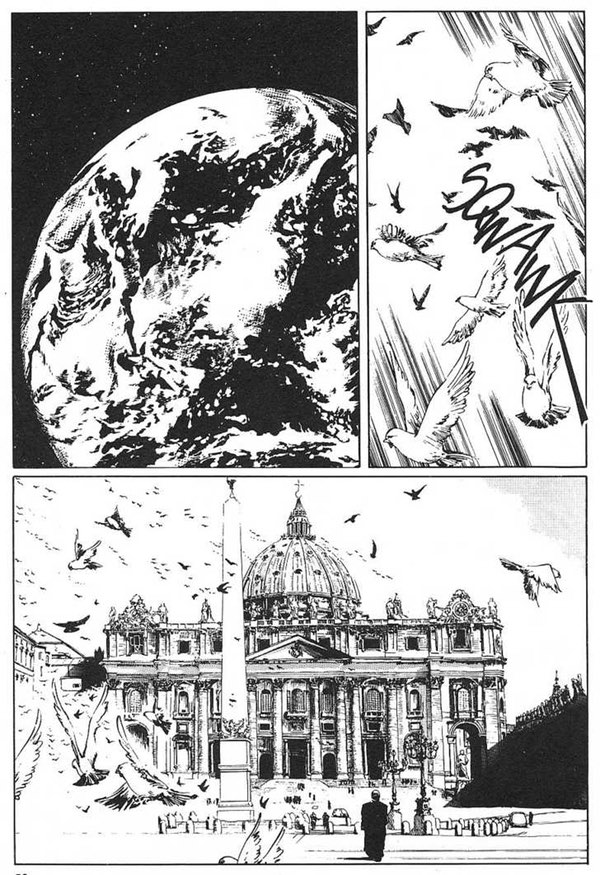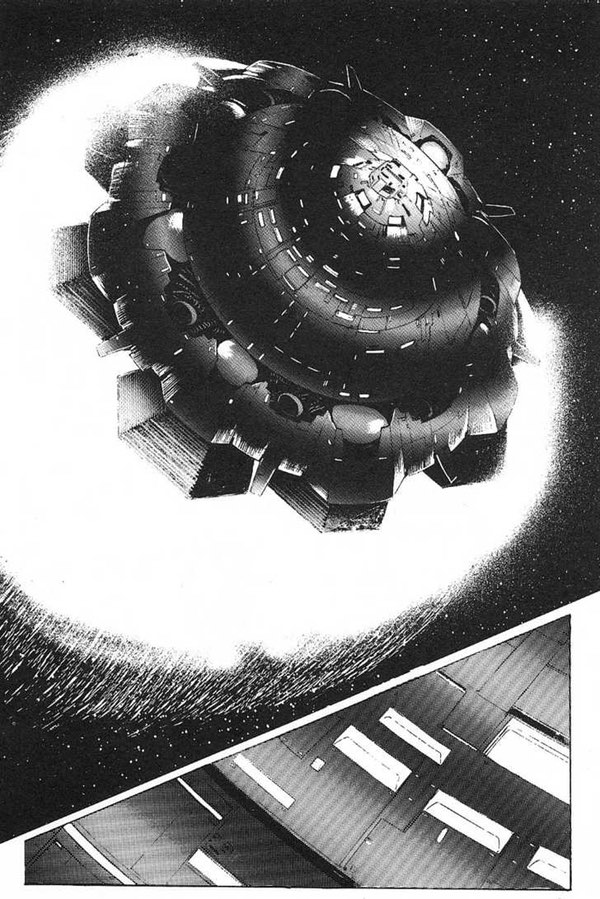
The devil’s planetby Dwayne Day
|
| A lot of the hardware and spaceships in Hoshino’s stories look like they could exist in the universe of Stanley Kubrick’s classic film. |
The hunt for “Planet X” or the tenth planet, or whatever terminology has been used, goes back over a century. Neptune was discovered after scientists noted irregularities in Uranus’ orbit. Similarly, Clyde Tombaugh found Pluto while chasing a theory that even with Neptune found, Uranus’ orbit was still odd enough to indicate there was a planet tugging on it. The theory was wrong, but Tombaugh found Pluto—a combination of mistaken inspiration and a hell of a lot of hard work.
The hunt for a distant planet, and occasionally its discovery, has also inspired various works of fiction. One such example was the story “Lucifer Rising” by Yukinobu Hoshino, in his 1984 manga series 2001 Nights, which had a clever and unique storyline. (You can read part 1 here and part 2 here.) 2001 Nights was eventually translated into English and published in the United States in the 1990s, and Hoshino was clearly inspired both by American and British science fiction, particularly Arthur C. Clarke. Much of Hoshino’s artwork was influenced by 2001: A Space Odyssey, and along with the storylines depicts hard, scientifically-based science fiction. A lot of the hardware and spaceships in Hoshino’s stories look like they could exist in the universe of Stanley Kubrick’s classic film.
 A panel from the manga “Lucifer Rising” about an expedition to a planet in the far outer solar system. (credit: Yukinobu Hoshino, 2001 Nights) |
“Lucifer Rising” starts with an asteroid mining crew stumbling across an unusual potential comet near Jupiter. When they get close to it they discover that it is a large frozen chunk of ice. But when an astronaut touches it, it explodes, killing them all. The object’s origin is then traced to a planet on the distant edge of the solar system that was discovered by space-based telescopes in the 1990s, a planet named “Lucifer,” even larger than Jupiter. Lucifer, clearly defiant, orbits the Sun in retrograde, a direction opposite of all the other planets, and is surrounded by a ring and three moons named Cassius, Brutus, and Judas.
The story then picks up on Earth at the Vatican, where the Pope meets with a scientist priest named Ramon Chavez. The Church has partially funded an expensive mission to Lucifer, and the Pope wants Chavez to participate as both a theologian and a scientist. The Pope is concerned that Lucifer may indeed be the devil’s planet, and he wants somebody he trusts to investigate it.
A jointly-funded expedition takes the spaceship Zefiro on a seven-year journey to Lucifer. But when the crew awakes from hibernation near Lucifer an astronaut has already died during the trip, an apparent murder. More deadly accidents follow, including two crewmembers who drown in their cabin when a pipe bursts and fills it with billions of weightless drops of water.
 A panel from the manga “Lucifer Rising” about an expedition to a planet in the far outer solar system. (credit: Yukinobu Hoshino, 2001 Nights) |
Chavez concludes that the early solar system consisted of matter and antimatter that cataclysmically annihilated each other until very little remained to form the planets and moons. Lucifer was an antimatter star with its own life-bearing planets, and drifted out into the darkness before finally cooling into a gas giant, most of its planets destroying each other and forming the rings. Occasionally pieces of its rings would cause extinctions on Earth, like wiping out the dinosaurs, or possibly providing the radiation to inspire mutations that ultimately led to the rise of humans.
Back on Earth, the Pope notes in a papal address that God created the solar system—the Sun, the Earth, and Lucifer—as an allegory for God, Man, and the devil. He announces that humanity should not be exposed to Lucifer and calls for the return of humans back to Earth, leaving space as the devil’s realm.
| “Lucifer Rising” combines science, religion, an adventure story, a murder mystery, and classic literature. It would form an excellent basis for a movie, or a lengthier novel. |
On the Zefiro, Chavez discovers that a member of the crew, a scientist, is behind the murders. The scientist had originally intended to kill Chavez, believing that the priest would use his theology to prevent scientific study of the planet. Chavez manages to prevent the scientist from sabotaging the entire mission, acknowledging that Lucifer needs to be studied scientifically, not shunned due to religious beliefs. At almost the same time these events are playing out in distant space the Pope dies, and his back-to-Earth movement falters. Humanity decides to send future missions to Lucifer to mine its antimatter as a source of unlimited energy. The story ends on a somewhat ambiguous note about the conflict between science and religion.
 A panel from the manga “Lucifer Rising” about an expedition to a planet in the far outer solar system. (credit: Yukinobu Hoshino, 2001 Nights) |
Hoshino’s story quotes extensively from Milton’s Paradise Lost, with its imagery of Heaven and Hell and the battles between darkness and light. At times the narration is overwrought, but Hoshino deserves credit for ambition. “Lucifer Rising” combines science, religion, an adventure story, a murder mystery, and classic literature. It would form an excellent basis for a movie, or a lengthier novel. Indeed, there are some indications that it has influenced other science fiction writers.
A planet far more massive than Jupiter orbiting even at a great distance would have been detected long ago because of its gravitational influence on the rest of the solar system. A former JPL scientist told me that the idea of a planet made of antimatter is intriguing, but it would be sweeping up—and annihilating—so many particles either from the Sun or the interstellar wind that it would be radiating a lot of hard gamma rays and would be easily detected. If there is a tenth planet out there in the void, as the Caltech scientists have proposed, it’s probably not made of antimatter, and certainly not bigger than Jupiter. But it probably is probably a very strange and eerie beast indeed.